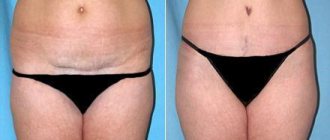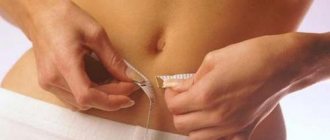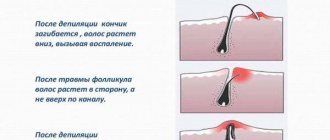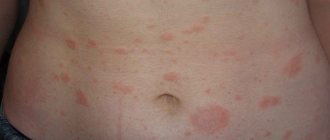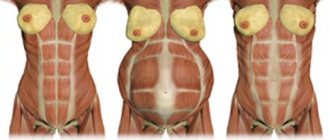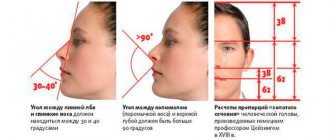Scars after tummy tuck heal under unfavorable conditions. This occurs due to the tightening of abdominal tissues, the presence of drainage and contraction of the abdominal wall muscles. To reduce the likelihood of complications to a minimum, surgeons use special suture material, as well as special suturing techniques. After the operation, antibiotics are prescribed and dressings are performed.
The number of scars varies depending on the plastic surgery technique; the appearance depends on the volume of intervention, the speed of recovery and the stage of healing.
Dependence of the shape of the scar on the type of abdominoplasty
| Classical | Vertical | Lateral |
|
|
|
| Extended | Circular | Mini |
|
|
|
Causes of edema
- During the procedure, a compensatory-adaptive reaction is activated. Mediators are released that increase the permeability of blood and lymphatic vessels. There is a movement of fluid and biomaterials into the tissue space for the destruction of damaged cells and activation of regeneration processes.
- The presence of a suture promotes blood flow, but outflow is hampered due to the formation of fibrous tissue. Circulation will be restored in 2-4 months, when new vessels form in the scar.
With a favorable course, swelling increases in the first week after surgery. A decrease is observed by 1-2 months, but water-salt metabolism is completely normalized after six months.
Caring for sutures after surgery
For speedy rehabilitation, it is necessary to follow all doctor’s prescriptions. The first day the wound is under an aseptic dressing. It is recommended to adhere to bed rest for 2 weeks. To relieve tension, a special compression corset is worn for 1.5–2 months.
Water treatments are prohibited. Physical activity should be avoided for the first couple of months. You should sleep with your knees bent on your side. Scars after abdominoplasty are treated with keratolytic, anti-inflammatory ointments and silicone-based gels. It is better to avoid exposure to ultraviolet radiation or apply sunscreen. For speedy healing, massage and physiotherapeutic procedures are recommended: ozone therapy, magnetic therapy, phonophoresis.
If after 12 months the patient is not satisfied with the defect, the issue of taking additional measures is decided. Use:
- Surgical removal of excess scar tissue;
- Fractional laser bleaching;
- Chemical peeling;
- Applying a tattoo to the operated area.
Conclusion: do not be afraid of scars after abdominoplasty; if you follow the doctor’s instructions, they will be barely noticeable. The main thing is the result.
The scarring process after abdominoplasty: causes, prevention and treatment of atrophic scars
Nature of scarring
After abdominoplasty, like any other abdominal manipulation, a scar will appear at the site of wound healing. This is the body's reaction to damage. The dense fibrous structure differs in appearance and function from healthy skin: it has a high collagen content (therefore it is elastic), there are no hair follicles and sweat glands.
Varies according to the phases of formation:
- the first phase is inflammatory, lasts from 5 to 7 days and consists of the formation of granulation cells, the incision site is purple in color and prone to swelling;
- the second is proliferation, lasting about a month; during this period, the granulation lining matures, capillaries appear in it, the formation decreases due to decreased swelling, and becomes a little lighter;
- the third - lasts about a year, is characterized by the replacement of the primary soft lining with a coarser permanent one. During this period, the scar takes on its final appearance, based on which its type can be determined.
Normotrophic scar (scar) after abdominoplasty
If a normotrophic scar has formed after abdominoplasty, the operation can be considered successful. Such scars are flat, thin, with smooth edges. To the touch and color they practically do not differ from the epithelium. They are sensitive, which is important for women who are sexually active.
Atrophic scar formed after abdominoplasty
Scars retracted relative to the main cover after abdominoplasty are called atrophic. They are light, insensitive, slightly elastic, and are the result of slow collagen synthesis.
Hypertrophic scar after plastic abdominoplasty
Appears due to inflammation, sprains and other unfavorable conditions during the healing period. Excessive collagen synthesis leads to excessive formation of connective tissue, which rises above the epithelium. Linear hypertrophic scars formed after abdominoplasty have a pink or reddish tint and uneven edges.
Keloid scar after corrective abdominoplasty
A keloid scar that appears some time after abdominoplasty is considered a serious cosmetic defect. In addition to its unaesthetic appearance, it makes itself felt by pain, itching, and burning. It is prone to constant growth and can exceed the wound surface in size, replacing healthy skin far beyond its boundaries.
Why does atypical formation occur?
It is almost impossible to predict how a scar will form after abdominoplasty surgery. This process is influenced by many factors: from the individual characteristics of the body (age, race, gender, heredity and immunity) to local ones (direction of the incision line, degree of skin tension, blood supply and lymph drainage).
Hypertrophy after abdominoplasty is quite reasonable.
- Tension of the edges of the wound and traumatism of the operation with violation of the integrity of capillaries and lymph flows.
- At risk are patients with a genetic predisposition to atypical scarring.
- In addition, the professionalism of the surgeon plays an important role. For example, excessive coagulation (soldering of capillaries), the use of inappropriate suture material, and inaccurate suturing will negatively affect the healing process.
Scar and its prevention after abdominoplasty
Timely prevention consists of simple, but daily caring procedures.
- Wearing compression garments, a bandage or a corset will help prevent excessive tension on the edges of the wound. A light massage effect activates blood flow and accelerates lymph outflow. Thanks to good compression, the epithelium adheres tightly to the subcutaneous layers, and its growth occurs faster. The correct silhouette is formed.
- Treatment with gels and ointments with anti-inflammatory, fibrinolytic, antithrombic and keratolytic effects. Such drugs promote cell regeneration and resist compaction and proliferation.
- Application of silicone plates. Reusable silicone products resist overgrowth and hardening. Can be used for a year until complete recovery.
Scar and its treatment after abdominoplasty
3-4 weeks after abdominoplasty, the scar can be subjected to physiotherapeutic treatment.
The most effective methods are medicinal electrophoresis, infrared irradiation, galvanization, darsonvalization, diadynamic therapy, phonophoresis, and paraffin treatment. Scar massage after abdominoplasty is prescribed after its complete epithelization. Corticosteroids may be prescribed as medications. They are injected, reduce inflammation and stimulate regeneration.
Excellent results can be observed after using laser therapy. Laser surface treatment allows you to painlessly remove the top rough layer. In cosmetology, erbium, carbon dioxide, neodymium, and pulsed lasers are used.
After abdominoplasty, the scar is subjected to cryodestruction. Refrigerants, in particular liquid nitrogen, are applied to the surface, subjecting it to freezing. The effect is achieved due to the cyclical nature of the procedure - freezing/thawing.
Despite the long list of treatment procedures, the width of the scar after abdominoplasty can only be changed surgically.
Abdominoplasty: appearance after surgery
What should my stomach look like after abdominoplasty? In order to avoid disappointment from the final result, computer modeling of the figure should be performed before the operation. With its help, it is easier for the patient to explain her wishes, and for the surgeon – the possibilities.
Pain after abdominoplasty
People resort to plastic surgery not only to improve their appearance. Excessive accumulation of fatty tissue contributes to the development of atony of the muscular frame, which causes the internal organs to droop. A decrease in intra-abdominal pressure leads to the appearance of chronic diseases of the digestive, excretory and reproductive systems.
When can you feel the effectiveness of abdominoplasty and when will your stomach stop hurting? The answers to these questions depend on the operating method. The endoscopic method is considered the most gentle. Therefore, the rehabilitation period does not last long. After classic abdominoplasty, the stomach hurts for several weeks, but the intensity of the pain gradually decreases.
The first time after abdominoplasty, the stomach is tightened with sutures, and it is impossible to see the effect. It is allowed to sleep and rest only on your back with a cushion placed under your knees; you should get out of bed carefully, and move slowly and carefully. But gradually the pain will subside, the swelling will subside, and the scar will heal. Then it will be possible to evaluate the renewed abdomen after abdominoplasty.
Swelling after abdominoplasty
Abdominoplasty involves trauma to several types of tissue: skin, fat, muscle fibers, as a result of which the abdomen often swells after abdominoplasty. The fact is that during the operation the lymphatic vessels are cut, in addition, lymph cannot circulate freely in the wound area. Therefore, swelling is considered a natural process after plastic surgery.
However, you should consult a doctor if the swelling does not decrease over a long period of time, it hurts even with light pressure, and is accompanied by a high temperature. In this case, it is necessary to remove excess fluid using drainage and take an additional course of antibiotics. After this, the abdomen after abdominoplasty will lose excess volume and recover faster.
A bandage will help reduce a swollen abdomen after abdominoplasty, since its function includes gentle massaging of the skin, accelerating the movement of blood and lymph. Avoid salty and spicy foods and sweet carbonated drinks. Their consumption causes thirst and retains fluid in the body. Among the cosmetic procedures, the most effective are body wraps, as well as lymphatic drainage and LPG massages.
Seam care
This lift involves a long incision above the pubic bone.
When suturing the edges of the skin-fat tissue, surgeons use a hidden suture technique, which leaves only a thin white scar several weeks after the procedure. It is located at the very bottom of the abdomen and is perfectly hidden under any underwear or swimsuit. In order for the scar to become as invisible as possible, you should properly care for the seam. The first days after surgery, the nurse independently treats the wound and changes the bandage. After returning home, the patient must perform these actions. It is very important to keep your hands and skin near the incision clean, as any dirt can lead to infection and other complications that prolong the recovery period and increase the volume of the scar.
Sometimes individual characteristics of skin scarring or long-term recovery after surgery lead to the fact that the seam turns out dark or voluminous. If you don't like the way your stomach looks after abdominoplasty, undergo a course of laser resurfacing or deep scar peeling. You can consolidate the effect with medicinal ointments and cosmetic creams and masks.
Lifestyle
Experts draw attention to the fact that it is possible to consolidate the results of abdominoplasty only by leading a healthy lifestyle. A non-flat stomach after abdominoplasty is observed in people who eat fast food, as well as homemade fatty and sweet dishes. Nutritionists advise adjusting your diet so that it is based on easily digestible protein foods, complex carbohydrates, fresh vegetables and fruits.
Quitting smoking and alcoholic beverages, regular exercise and quality facial and body care will make your figure fit and seductive.
Types of abdominoplasty
There are full, mini and endoscopic abdominoplasty.
Full abdominoplasty is performed under general anesthesia. The patient undergoes a preliminary examination, takes the necessary tests, and prepares.
The duration of the operation is from two to six hours. With full abdominoplasty, the navel is transferred, the skin flap is completely detached to the costal arches, excess skin and fat are removed, and muscles are sutured. Then the doctor stitches and inserts drains. The patient is wearing compression stockings. He will walk in it from a month to three.
In this type of surgery, an incision is made along the bikini line (from hip to hip). Sometimes a deeper incision is made (on the sides). This is the case if the stomach hangs not only in front, but also from the sides. The location of the incision and the expected length are discussed with the surgeon before surgery. Another small scar will remain around the navel.
As a rule, the sutures fade during the first year after surgery.
Mini abdominoplasty is also performed under general anesthesia. The operation time is significantly reduced compared to a full abdominoplasty.
The incision for this operation is also located in the bikini area, but it is much shorter.
The rehabilitation period is much faster and easier. In this type of operation, the navel remains in its place and a small flap of skin is removed.
Endoscopic abdominoplasty is performed through small punctures (incisions). It is performed by tightening the abdominal muscles without removing excess fat or skin. After it, the scars are almost invisible.
Abdominoplasty: photo and markings
Before the operation, the surgeon will take several photographs (full face, profile and third of a turn). He will also make careful markings on the body. This is one of the important parts in preparing for surgery. The more correctly and carefully the markings are applied, the better the result of the operation will be.
Technique
This procedure has several options. Classic abdominoplasty takes from 1 to 5 hours, depending on the complexity. During this time, the patient is made several incisions in the abdomen, and part of the skin is removed. Through the incisions, the surgeon eliminates muscle discrepancies and removes excess fat and skin. Then, if necessary, the navel is secured in a new position, drains are installed so that the remaining contents can flow out, and cosmetic sutures are placed on the incisions. It is also worth noting that the procedure is performed only under general anesthesia.
After abdominoplasty
The first days after surgery are difficult for many. After the operation, the patient is transferred to a ward, where he is placed in a semi-recumbent position and his legs are raised up. This is necessary in order to minimize skin tension in the abdominal area. When the patient finally recovers from anesthesia, he may experience nausea and dizziness, which will subside within a few hours. On the second day after the operation, the patient will be able to stand up, but walking is allowed only in a half-bent position. Also on this day, the first dressing is done and the seam is processed. After abdominoplasty, the abdomen will become hard, and when pressed, there will be discomfort, since the procedure affected muscle tissue that needs time to recover. Severe pain does not occur, because high-tech drugs can reduce any discomfort after surgery to a minimum. Therefore, your doctor may prescribe a course of antibiotics or painkillers. When the patient has more or less recovered (in 4-5 days) and the risk of complications has disappeared, the patient will be discharged home, where he will continue his rehabilitation on his own.
